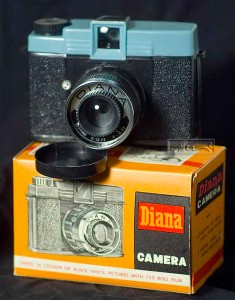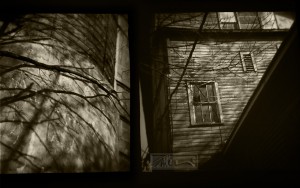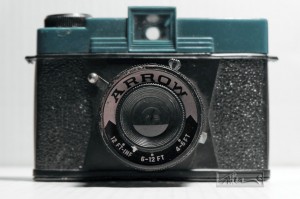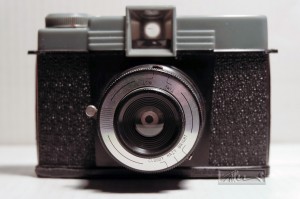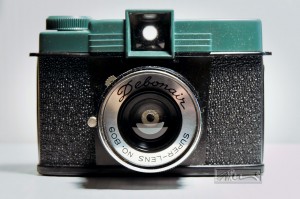There is a huge difference in functionality and creative play between the original Diana camera and its somewhat bogus modern reproduction called the Diana F+ from Lomography.
While many use the newer likeness, most real Diana shooters prefer to use the original camera from the 1960’s. For the hardcore, the Diana 151 or the Diana F are the ones to use. For others and myself, the new version is just too refined, too slick and a little too much money. While it may look like an original, on close inspection it seems more like a repackaged Holga than a true Diana.
The original Diana was the real deal. It is the one with what most of its users feel had the correct amount of quality control. The original version was an actual camera and it could produce real pictures. It said so right on the box.
By today’s standards, the camera was not a very refined device. In fact, it had a number of flaws. It usually leaked light and had to be taped to seal the light chamber, the plastic strap was useless, the primitive plastic viewfinder was not very accurate and the 120 roll film often got jammed or did not wind as tightly as needed. Precautions had to be taken when loading, while shooting and when removing the film. Even the little red window needed to be taped over to protect the film from light.
Because it only weighs a few ounces, it can often be difficult to hold steady when using its approximate 1/60th of a second shutter. That shutter speed setting is referred to as “I” or instant. There is no double exposure prevention. The photographer must pay attention to the shooting sequence in order to know that the exposure has been made and must advance the film to prevent double exposures. However, it is those flaws that made the camera both challenging and rewarding. It was those flaws that helped produce the amazing imagery that we associate with this amazing little camera. Interestingly, it actually took very interesting images. What the Diana lover liked about it was exactly what others did not. Its lack of sophistication was part of the attraction.
The images were usually produced as a series of 16 4-cm X 4-cm square frames on 120 film. Tri-X was more than likely the preferred film. Black photo-tape was considered an essential accessory.
The most amazing part of the camera was its low-quality plastic lens, which produced various levels of sharpness, blurriness throughout the image as well as vignettes in the corners and flare. The results were images that had the feel of dreams or remembrance. It was that generally soft focus look that artists liked and found appealing.
Of course, there were always other factors that contributed to the “effects” besides the lens. There were no coatings on the simple meniscus lens and no lens shade to prevent flare. Due to all of the variables, it seemed that no two Diana cameras could ever produce the same results. For that reason, I often used several cameras on a single subject. Unlike a modern digital, there was no way to determine what you had captured until the film was developed. It was a way to enhance the possibilities.
In the early seventies, there was an interest in the Diana as a serious camera by art photographers and by fine art photography instructors who saw the camera as a simple and inexpensive way to teach photography. It had all of the controls needed to demonstrate the basic functions of a camera. It had a lens with a variable aperture and focus. It had a single instant shutter speed and a B setting for making long exposures. It made some pretty unique looking images. For a class of students, it was a way of leveling the playing field. It also allowed the user to look and see what there was to shoot.
Made in Hong Kong by the Great Wall Plastic Company, the original Diana was produced so cheaply, that it was used as a promotional giveaway. I’ve heard that the sales price was less than a buck. It was something you might win for buying a few gallons of gas or maybe given as a souvenir at a party or a sales convention. It was meant to be a door prize or a cheap toy. As such, there were many, which that had the branding for restaurants and pizza parlors inscribed on the top or on the lens ring.
The Diana and its clones were produced by the thousands and nearly everyone I knew had one that they figured wouldn’t really work. It ended up in the bottom of the closet. It was simply something they had won. It was much like winning a cheap trophy at the fair.
The Diana is considered to be a toy camera. Today, there are many photographers who play with toy cameras of all kinds. The Diana was one of the triggers for this movement.
Besides the Original Diana and the Diana F, there were many clones that had slight differences. The basic difference between the Diana and The Diana F was that the Diana F had a means of attaching and syncing a flash. The F stood for flash.
Diana clones such as the Arrow, Debonair, Windsor, Anny, Banner, Stellar, Diana Deluxe, Hi-Flash, and Dories, retained the same basic look and feel as the Diana, but when closely compared they usually had fewer controls and often were less robust. I am sure they were also sold in many countries with names I’ve never seen.
Of all the clones that I am aware, the best and most robust in my opinion are certain models of the Debonair. I personally feel that the Debonair is a better camera than the Diana in build quality. However, there are some who would argue.
I used to load a half dozen or so Diana cameras with film, tape them up and toss them into a black garbage bag when I went out shooting. Once I had exposed the roll on one camera, I would simply grab another and keep on shooting. The use of a garbage bag was to protect the cameras from the light when not in use.
The Diana is a tool for loosening up the act of making pictures. What one learns from using these simple contraptions can be useful for all types of photography. You learn to concentrate more on the subject and less on the camera. You learn to anticipate the outcome. You shoot to see what happens. You begin to appreciate serendipity, the happy accident and the simplicity of the snapshot.
Those who use it see the Diana as a form of simple pleasure. Others see it as a way to make images that are spontaneous, unique and meditative.
While the simplicity made it a kind of point and shoot, for many, the Diana was basically a point and pray camera.
Nancy Rexroth is an artist photographer that is probably the best known of all the Diana photographers. Her 1970’s book entitled “Iowa” is a series of photographs, which evoke a dreamlike recollection of her Midwestern childhood. The plastic lens of her Diana rendered her subjects as fading memories and dreamscapes. Her Diana proved ideal for reproducing a feeling of distant past and in depicting dreams.
For many, including myself, the Diana has been a very playful, but serious image-maker.
Links:
- Diana – Camerapedia
- Diana (camera) – Wikipedia, the free encyclopedia
- Plastic Cameras: Toying with Creativity – Michelle Bates
Read more about other great photographic techniques in my book Rethinking Digital Photography.
Please have a look at some of my other posts here.
NOTICE of Copyright: THIS POSTING AS WELL AS ALL PHOTOGRAPHS, GALLERY IMAGES, AND ILLUSTRATIONS ARE COPYRIGHT © JOHN NEEL AND ARE NOT TO BE USED FOR ANY PURPOSE WITHOUT WRITTEN CONSENT FROM THE WRITER, THE PHOTOGRAPHER AND/OR lensgarden.com. THE IDEAS EXPRESSED ARE THE PROPERTY OF THE PHOTOGRAPHER AND THE AUTHOR.


